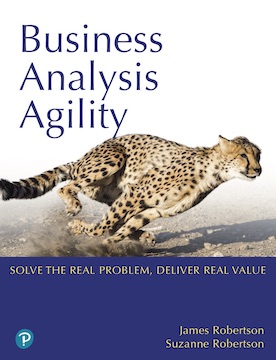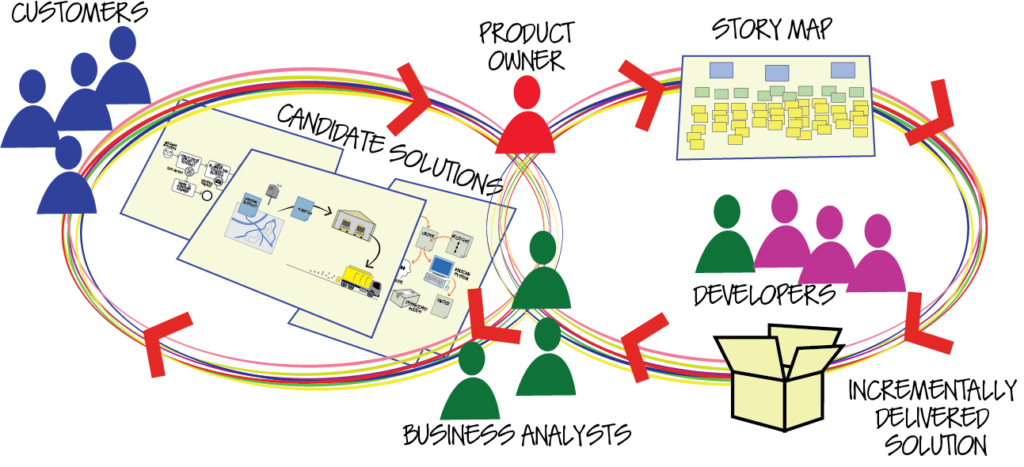
Business Analysis
Solving the right business problem is absolutely crucial for software and product development. Therefore the emphasis of this course is to show you how to work with your customers in a more agile way to ensure that you—and they—discover the right problem. In short, we show you how the business analyst is crucial to good agile development, and how you become a valued member of the agile team.
‘Very good explanations when questions aired. Lots of real life examples too.’ — Claire Pearson, Business Process Analyst, AQA
Business Analysis Agility shows you how to:
o Understand and solve your customer’s real business problem
o Be more responsive to your customers and their real work
o Discover the capabilities of your customers and design better solutions for them
o Work in an agile and iterative manner with your customers
o Work in synchronisation with the agile development team
o Communicate more precisely with the developers by writing the right stories
HOW DOES THIS WORK?
The business analysts work closely with the customers to establish their work and its needs, and to ensure that the real business problem—it’s not always obvious, and not always what is said—is clearly understood by everybody.

To uncover the problem, the agile business analyst uses multiple candidate solutions to probe the customers, their objectives and their values. Candidate solutions are the preferred way of working as they have shown themselves to be extremely effective at prompting customers to reveal their real problems and underlying needs.
Business analysts use a story map to communicate the requirements for the solution to the developers. This means that the analysts and the developers work together iteratively and incrementally. The analysts are adding stories about the needs of the solution and the customers as the developers enhance and retrieve the stories in time for each development cycle. With co-ordination from the product owner, the analysts and the developers synchronise their efforts so business analysis results are delivered just in time for the next development cycle.
The emphasis throughout is on close collaboration, and a relentless focus on solving the right problem.
What’s in it for Me?
This course gives you a different approach to business analysis. This one provides a business analysis framework that works regardless of whether you are part of an agile environment and need to provide stories for iterative development, or whether you are in a traditional environment and need to produce a requirements specification suitable for more formalised environments and outsourcing.
You learn how to:
- Find the customer (or user) segments, and determine which of them yields the best, and the earliest value
- Use safe-to-fail probes to ensure that a candidate solution solves the right problem and delivers the right value.
- Deploy an iterative approach to discovering the real problem, and progressively feed the right stories to the delivery activity.
- Understand that by discovering the right needs and solving the right problem, you deliver real value to your customer and your sponsor.
- Do business analysis more quickly and effectively.
Who is This For?
Business analysis is a skill that should be present in all development efforts, and in day-to-day organisational tasks. The skill is usually, but not necessarily, associated with job titles such as:
- Business Analyst
- Product Owner
- gile Team Member
- Systems Analyst
- Requirements Engineer
- Product or Program Manager
or similar. We also find Business Stakeholders, Users, Software Customers and Testers benefit from learning advanced business analysis techniques, and how they can contribute to the organi sation’s wellbeing.
What’s in the Course?
agile Business Analysis
The opening section presents a framework for discovering the customers and their needs, for finding solutions and evaluating them, designing the business solution and getting it built. It looks at how business analysis integrates with either agile or traditional development.
Do You Know What Your Customers Value?
How to identify and prioritise customer segments. For the highest priority segments, you determine value propositions that set down what you must deliver to satisfy the customers’ business needs. This value proposition is the foundation for solving the problem.
Are You Solving the Right Problem?
You and your customers generate candidate solutions. Then to prove that a candidate is solving the right problem, it is the subject of a safe-to-fail probe. This is a quick, cheap experiment to determine the viability, the suitability and the outcome of a solution. Most importantly, you ensure the candidate solves the right problem and fulfils the right need.
Investigate the Solution Space
The solution space includes the people, software and devices used to meet the needs of the customer segments. You investigate this space by looking at the necessary business processes and data.
Designing the Solution
AHere you form the business solution to make it usable and convenient. The designing business analyst uses elements of the problem, the desired impact of the solution, the behaviour of the target customer segments, and the value proposition to craft the best possible solution.
Writing the Right Stories
Stories are fundamental to most agile development. However, if they are to be useful, the stories must be the right stories. This section gives you an approach to writing the right stories, ones that address the real customer problems. We also show you how story maps give you a more descriptive and usable backlog. Story maps are the ideal repository for the information you are discovering, and the stories needed for the development cycles.
Jack Be Nimble Jack Be Quick
TThis section reviews the course, shows how the business analysis activites are overlapping and itertive, discusses other aspects of business analyis, and shows you how by being agile, business analysis can be done quickly and effectively.
Instructors — learning from experience
James Robertson is a consultant, teacher, author, project leader whose deep understanding of business analysis and customer-obsessive techniques has helped teams all over the world. He is a founder of The Atlantic Systems Guild, a think tank known for its innovative systems engineering techniques.
He is co-author of Mastering the Requirements Process—Third Edition, Getting Requirements Right (Addison-Wesley 2012), Requirements-Led Project Management Addison-Wesley 2005), Adrenaline Junkies and Template Zombies (Dorset House, 2008) and the Volere techniques for requirements.
Adrian Reed is an enthusiastic business analyst and advocate of the BA profession. His career started in an insurance broker’s office, where he was involved in process improvement and optimising information systems long before he knew about any formal BA techniques. His next job was for a multinational insurer, and this is when he first came across the “formal” BA role and found that it was the perfect fit for him. His career has spanned various BA and leadership roles within the financial services industry, working on a range of tricky projects in very different contexts in different companies.
Today he is Principal Consultant for Blackmetric, a niche business analysis consulting and training firm, and works with clients in a wide range of domains. He is a past president of the International Institute of Business Analysis (IIBA) UK chapter, an international speaker and regular blogger. Adrian wrote the 2018 book, “Business analyst” (published by BCS) which discusses the breadth of the BA career, and the 2016 book “Be a great problem solver… now” (published by Pearson). He also contributed to the 2013 book “Business Analysis and Leadership” (published by Kogan Page).
Adrian holds the BCS International Diploma in Business Analysis, the IIBA Certified Business Analysis Professional (CBAP) and the BA Manager Forum Expert BA Award. He delivers both ‘Mastering the Requirements Process’ and ‘Business Analysis Agility’ courses. Adrian has a strong business analysis background, having worked on a wide range of strategic projects across a variety of business domains, geographies and technologies.
For more information …
For information about in-house or public courses, consulting or other services, contact us or your nearest agent. Scheduled public courses are shown in the Volere events column of the Home page.
